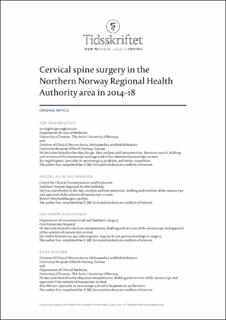| dc.contributor.author | Ingebrigtsen, Tor | |
| dc.contributor.author | Guldhaugen, Kristel Ailin | |
| dc.contributor.author | Kristiansen, Jon-André | |
| dc.contributor.author | Kloster, Roar | |
| dc.contributor.author | Grotle, Margreth | |
| dc.contributor.author | Solberg, Tore | |
| dc.coverage.spatial | Northern Norway | en_US |
| dc.date.accessioned | 2023-01-04T14:19:44Z | |
| dc.date.available | 2023-01-04T14:19:44Z | |
| dc.date.created | 2022-10-31T17:11:30Z | |
| dc.date.issued | 2022-02-28 | |
| dc.identifier.issn | 0029-2001 | |
| dc.identifier.issn | 0807-7096 | |
| dc.identifier.uri | https://hdl.handle.net/11250/3041018 | |
| dc.description.abstract | Background: Knowledge about the variation in treatment rates is needed to assess whether the access to health services is equitable. The objective of this study was to investigate the rates of surgical treatment of degenerative cervical spine disease in Norway and the Northern Norway Regional Health Authority area and the local coverage in the Northern Norway Regional Health Authority area, and to assess the activity in the region.
Material and method: We included cervical spine procedures recorded in the Norwegian Patient Registry from the years 2014–18 and estimated age-standardised treatment rates for Norway, the health regions and health trusts in Northern Norway Regional Health Authority. We estimated the local coverage as the proportion of patients resident in the Northern Norway Regional Health Authority area who had undergone surgery at the University Hospital of North Norway in Tromsø.
Results: The treatment rate remained stable at an average of 29.6 surgical procedures per 100 000 inhabitants (aged 18–105) per year. The rate for residents in the Northern Norway Regional Health Authority area was 23.0 procedures per100 000 inhabitants per year (78 % of the national average). The rates in Finnmark and the areas of residence served by the University Hospital of North Norway were close to the national average. Residents in the Nordland and Helgeland areas had lower rates in each year of the study period, with an average of 16.6 and 18.1 procedures per 100 000 inhabitants per year respectively. This corresponds to 56 % and 61 % of the national average. Local coverage in the Northern Norway Regional Health Authority area increased from 69 % in 2014 to 91 % in 2018.
Interpretation: The treatment rate for degenerative cervical spine disease was lower in the Northern Norway Regional Health Authority area than in the rest of Norway. For this to be compensated and the local coverage to be increased to 100 %, we have estimated that the activity needs to be increased by approximately 35 surgical procedures per year. | en_US |
| dc.language.iso | eng | en_US |
| dc.publisher | Den norske legeforening | en_US |
| dc.relation.ispartofseries | Tidsskrift for Den norske legeforening;Nr. 4 - Årgang 142 | |
| dc.rights | Attribution-NoDerivatives 4.0 Internasjonal | * |
| dc.rights.uri | http://creativecommons.org/licenses/by-nd/4.0/deed.no | * |
| dc.subject | Cervical spine surgery | en_US |
| dc.subject | Surgical treatment rates | en_US |
| dc.subject | Northern Norway Regional Health Authority | en_US |
| dc.subject | Regional health authority coverage | en_US |
| dc.subject | Health service quality | en_US |
| dc.title | Cervical spine surgery in the Northern Norway Regional Health Authority area in 2014-18 | en_US |
| dc.title.alternative | Nakkekirurgi i Helse Nord 2014–18 | en_US |
| dc.type | Peer reviewed | en_US |
| dc.type | Journal article | en_US |
| dc.description.version | publishedVersion | en_US |
| cristin.ispublished | true | |
| cristin.fulltext | original | |
| cristin.qualitycode | 1 | |
| dc.identifier.doi | https://doi.org/10.4045/tidsskr.21.0628 | |
| dc.identifier.cristin | 2067017 | |
| dc.source.journal | Tidsskrift for Den norske legeforening | en_US |
| dc.source.volume | 142 | en_US |
| dc.source.issue | 4 | en_US |
| dc.source.pagenumber | 10 | en_US |

